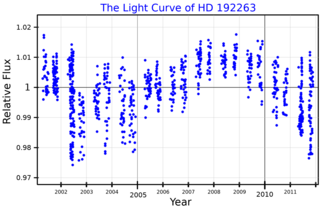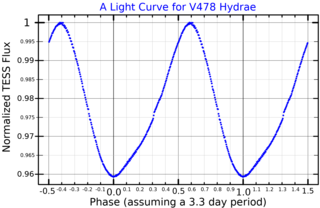Related Research Articles
HD 88133 is an 8th magnitude star in the constellation of Leo. It is classified as a yellow main sequence star. It is slightly more massive than the Sun, cooler and more luminous. Located at a distance of 241 light years from Earth it is not in our immediate neighbourhood and thus not visible to the unaided eye. With a small telescope it should be easily visible.
HD 83443 is an orange dwarf star approximately 134 light-years away in the constellation of Vela. As of 2000, at least one extrasolar planet has been confirmed to be orbiting the star. The star HD 83443 is named Kalausi. The name was selected in the NameExoWorlds campaign by Kenya, during the 100th anniversary of the IAU. The word Kalausi means a very strong whirling column of wind in the Dholuo language.

HD 192263 is an 8th magnitude star about 64 light years away in the constellation of Aquila. The spectral type of the star is K2V, meaning that it is an orange dwarf, a type of star somewhat cooler and less luminous than the Sun. It is not visible to the unaided eye, but with good binoculars or small telescope it should be easy to spot.
HD 102195 is an orange-hued star in the zodiac constellation of Virgo with a confirmed exoplanet companion. With an apparent visual magnitude of 8.07, the star is too faint to be seen with the naked eye. The distance to HD 102195 can be estimated from its annual parallax shift of 34.06 mas, yielding a separation of 95.8 light years. It is moving further away from the Earth with a heliocentric radial velocity of 1.85 km/s. This is a high proper motion star and a possible member of the η Cha stellar kinematic group.
HD 224693, also named Axólotl, is a star in the equatorial constellation of Cetus, and is positioned near the western constellation border with Aquarius. It can be viewed with a small telescope but is too faint to be seen with the naked eye, having an apparent visual magnitude of 8.23. Based on parallax measurements, the object is located at a distance of approximately 306 light years from the Sun. It is drifting further away with a radial velocity of 1.5 km/s.
HD 175541 is an 8th magnitude star with an exoplanetary companion in the constellation Serpens. It has the proper name Kaveh, which was selected by Iran during the NameExoWorlds campaign as part of the 100th anniversary of the IAU. Kaveh is one of the heroes of Shahnameh. The apparent visual magnitude of 8.02 is too faint for this star to be visible in the naked eye. It is located at a distance of approximately 424 light years from the Sun based on parallax measurements, and is drifting further away with a radial velocity of +20 km/s. Despite its distance, it was given the number 736 in the Gliese Catalogue of Nearby Stars.

HD 70573 is a variable star in the equatorial constellation of Hydra. At a mean apparent visual magnitude of +8.7, this yellow-hued star is too dim to be visible to the naked eye. Based upon parallax measurements, it is located at a distance of 193 light years from the Sun, and is drifting further away with a radial velocity of 20.5 km/s. It is a candidate member of the proposed Hercules-Lyra Association of co-moving stars, although this membership is disputed.
HD 210702 is an orange subgiant star located approximately 177 light-years away in the constellation of Pegasus. With a mass of 1.8 times that of the Sun, the star spent its main-sequence life as an A-type star. The visual luminosity is 11.38 times that of the Sun and the magnitude is near the naked-eye limit, but binoculars can easily see it.
HD 5319 is an 8th magnitude star approximately 319 light years away in the constellation Cetus. It is a subgiant star of spectral type K3, having run out of hydrogen in its core. When it was main-sequence, the spectral type was early F or late A.
HD 192699 b, also named Khomsa, is an exoplanet located approximately 214 light-years away in the constellation of Aquila, orbiting the star HD 192699. This planet was discovered in April 2007, massing at least 2.5 times the mass of Jupiter (MJ). Despite its orbital distance more than that of Earth, the orbital period is less than a year, because the parent star is more massive than the Sun.
HD 210702 b is an exoplanet located approximately 177 light-years away in the constellation of Pegasus, orbiting the star HD 210702. This planet, together with HD 175541 b and HD 192699 b, are planets around intermediate mass stars that were announced in April 2007 by Johnson et al. It has at least twice the mass of Jupiter and it orbits with semimajor axis of 1.17 AU, corresponding to a period of 341.1 days.
HD 175541 b, also named Kavian, is a jovian planet located approximately 424 light-years away in the constellation of Serpens, orbiting the star HD 175541. This planet was discovered in April 2007. Despite the distance of planet to star slightly more than Earth to the Sun, the period is less than 300 days that orbits in an eccentric orbit, because the parent star is 65% more massive than the Sun.
HD 43197 is a star with an exoplanetary companion in the southern constellation of Canis Major. It has been given the proper name Amadioha, as selected by Nigeria during the NameExoWorlds campaign that celebrated the 100th anniversary of the IAU. Amadioha is the god of thunder in Igbo mythology. It has an apparent visual magnitude of 8.98, meaning this is a ninth magnitude star that is too dim to be visible to the naked eye. The system is located at a distance of 204 light-years from the Sun based on parallax measurements, and is drifting further away with a radial velocity of +72 km/s. It made its closest approach some 583,000 years ago when it came to within 87 light-years.
HD 175167 is a star with an exoplanet companion in the southern constellation of Pavo. It is too faint to be visible with the naked eye at an apparent visual magnitude of 8.01. The system is located at a distance of 232 light years from the Sun based on parallax measurements, and it is drifting further away with a radial velocity of 5 km/s. It shows a high proper motion, traversing the celestial sphere at an angular rate of 0.190 arcsec yr−1.
HD 180902 is a binary star approximately 342 light years away in the constellation Sagittarius. The primary is a K-type star while the nature of the secondary is unknown since it has only been detected by its effect on the radial velocity of the primary.
HD 98219, also named Hunahpú, is a subgiant star in the constellation Crater. It has a confirmed exoplanet. At around 4 billion years old, it is a star around 1.3 times as massive as the Sun that has cooled and expanded to 4.5 times the Sun's diameter, brightening to be around 11 times as luminous. The International Astronomical Union (IAU) gave the opportunity to Honduras to name the star Hunahpú as part of NameExoWorlds. Hunahpú was one of the twin gods who became the Sun in K'iche' (Quiché) Mayan mythology.
HD 108863 is a subgiant star, the primary of a binary star system 540 light-years away, belonging to spectral class K0. Its age is younger than the Sun's at 1.8±0.4 billion years. The primary star is slightly enriched in heavy elements, having 115% of solar abundance. The primary star does not have detectable flare activity.
HD 99706 is an orange-hued star in the northern circumpolar constellation of Ursa Major. With an apparent visual magnitude of 7.65, it is too dim to be visible to the naked eye but can be viewed with a pair of binoculars. Parallax measurements provide a distance estimate of approximately 480 light years from the Sun, and the Doppler shift shows it is drifting closer with a radial velocity of −30 km/s. It has an absolute magnitude of 2.12, indicating it would be visible to the naked eye as a 2nd magnitude star if it were located 10 parsecs away.
HD 212771, also named Lionrock, is a solitary star in the southern zodiac constellation Aquarius. It has an apparent magnitude of 7.60, making it readily visible with binoculars but not the naked eye. Parallax measurements place the object at a distance of 364 light years, and is currently receding with a radial velocity of 15 km/s.
HD 203473 is a star in the equatorial constellation Equuleus. With an apparent magnitude of 8.23, it’s only visible by using an amateur telescope. The star is located at a distance of 237 light years based on its parallax shift but is drifting closer at a high rate of 61.7 km/s. As of 2014, no stellar companions have been detected around the star.
References
- 1 2 3 4 5 Brown, A. G. A.; et al. (Gaia collaboration) (August 2018). "Gaia Data Release 2: Summary of the contents and survey properties". Astronomy & Astrophysics . 616. A1. arXiv: 1804.09365 . Bibcode: 2018A&A...616A...1G . doi: 10.1051/0004-6361/201833051 . Gaia DR2 record for this source at VizieR.
- 1 2 3 4 Anderson, E.; Francis, Ch. (2012), "XHIP: An extended hipparcos compilation", Astronomy Letters, 38 (5): 331, arXiv: 1108.4971 , Bibcode:2012AstL...38..331A, doi:10.1134/S1063773712050015, S2CID 119257644.
- ↑ Houk, N.; Swift, C. (1999), "Michigan catalogue of two-dimensional spectral types for the HD Stars", Michigan Spectral Survey, Ann Arbor, Michigan: Department of Astronomy, University of Michigan, 5, Bibcode:1999MSS...C05....0H
- ↑ Brewer, John M.; et al. (2016), "Spectral Properties of Cool Stars: Extended Abundance Analysis of 1,617 Planet-Search Stars", The Astrophysical Journal Supplement Series, 225 (2): 32, arXiv: 1606.07929 , Bibcode:2016ApJS..225...32B, doi:10.3847/0067-0049/225/2/32, S2CID 118507965.
- ↑ "HD 192263". SIMBAD . Centre de données astronomiques de Strasbourg . Retrieved November 8, 2018.
- ↑ Johnson, John Asher; et al. (2007). "Retired A Stars and Their Companions: Exoplanets Orbiting Three Intermediate-Mass Subgiants". The Astrophysical Journal. 665 (1): 785–793. arXiv: 0704.2455 . Bibcode: 2007ApJ...665..785J . doi: 10.1086/519677 .
- ↑ "Approved names". NameExoworlds. Retrieved 2020-01-02.
- ↑ "International Astronomical Union | IAU". www.iau.org. Retrieved 2020-01-02.
- ↑ Luhn, Jacob K.; et al. (2019). "Retired A Stars and Their Companions. VIII. 15 New Planetary Signals around Subgiants and Transit Parameters for California Planet Search Planets with Subgiant Hosts". The Astronomical Journal. 157 (4). 149. arXiv: 1811.03043 . Bibcode:2019AJ....157..149L. doi:10.3847/1538-3881/aaf5d0. S2CID 102486961.